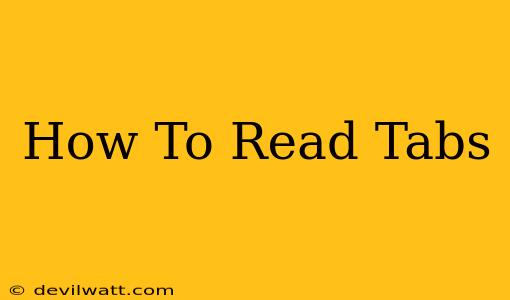Reading tabs might seem daunting at first, but with a little practice, you'll be decoding guitar tablature like a pro. This comprehensive guide breaks down everything you need to know, from understanding the basics to mastering more advanced techniques. Whether you're a complete beginner or looking to refine your tab reading skills, this guide will help you unlock the secrets of this musical shorthand.
Understanding Tablature (Tabs)
Guitar tablature, or tabs, is a simplified way to represent musical notation specifically for fretted string instruments like guitars, basses, and ukuleles. Instead of using traditional musical notation with notes on a staff, tabs use numbers to indicate which fret to press on each string.
The Basics of a Tab
A tab typically looks like this:
e|--0---2---0---3---
B|--1---3---1---3---
G|--0---0---0---0---
D|--2---0---2---0---
A|--3---x---3---x---
E|--x---x---x---x---
- Each Line Represents a String: The top line represents the high E string (thinnest string), and the bottom line represents the low E string (thickest string). This is standard tuning. If the tuning is different, it will usually be specified at the top of the tab.
- Numbers Indicate Frets: The numbers on each line tell you which fret to press down on that string. A "0" means to play the open string (no fret pressed).
- "x" Indicates a Muted String: The "x" signifies that you should mute the string, preventing it from ringing out.
- Spacing and Rhythm: The spacing between the numbers generally indicates the rhythm. Closer numbers mean shorter notes, while wider spacing suggests longer notes. However, precise rhythm is often indicated separately (e.g., using a drum tab or separate rhythmic notation).
Deciphering Tablature: A Step-by-Step Approach
Let's walk through reading a simple tab example:
e|--0---2---0---
B|--1---3---1---
G|--0---0---0---
D|--2---0---2---
A|--3---x---3---
E|--x---x---x---
-
Identify the Strings: Start by recognizing which string each line represents (E A D G B e).
-
Read the Numbers: The numbers tell you which fret to press down on each string. For the first note, you'd play the open E string (0 on the top line), the first fret on the B string (1 on the second line), the open G string (0 on the third line), the second fret on the D string (2 on the fourth line), the third fret on the A string (3 on the fifth line), and mute the low E string (x on the bottom line).
-
Play the Notes: Strum or pick the strings according to the numbers and mute as needed. Repeat for each set of numbers.
-
Interpret the Rhythm: While this simple example doesn't have complex rhythms, more complex tabs will require attention to spacing and any accompanying rhythmic notation to determine note duration.
Beyond the Basics: Advanced Tab Reading Techniques
- Slashes and Other Symbols: Tabs often use slashes (/) to indicate a change in chord or position. Other symbols may indicate bends, slides, vibrato, hammer-ons, and pull-offs. These require further research and practice.
- Multiple Lines: Some tabs may have several lines above the string notation to show lyrics, chords, or other information.
- Different Tunings: Always check the tuning indicated at the top of the tab, as this is crucial for accurate playing.
Tips for Effective Tab Reading
- Start Slow: Begin with simple tabs and gradually increase the complexity as you improve your skills.
- Practice Regularly: Consistent practice is key to mastering tab reading.
- Listen to the Song: Listening to the song while reading the tab will help you understand the rhythm, timing, and overall feel of the music.
- Use a Metronome: A metronome can help you develop accurate timing and improve your rhythm.
- Utilize Online Resources: Numerous websites and videos offer tutorials and explanations of advanced techniques in tab reading.
By following these steps and practicing consistently, you'll become proficient at reading guitar tabs and unlocking a vast world of musical possibilities. Remember, patience and persistence are key! Happy playing!

